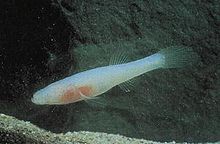Ozark cavefish
| Ozark cavefish | |
|---|---|

| |
| Scientific classification | |
| Domain: | Eukaryota |
| Kingdom: | Animalia |
| Phylum: | Chordata |
| Class: | Actinopterygii |
| Order: | Percopsiformes |
| Family: | Amblyopsidae |
| Genus: | Amblyopsis |
| Species: | A. rosae
|
| Binomial name | |
| Amblyopsis rosae (C. H. Eigenmann, 1898)
| |
The Ozark cavefish, Amblyopsis rosae, is a small subterranean freshwater fish endemic to the United States. It has been listed as a threatened species in the US since 1984; the IUCN lists the species as Near Threatened. It is listed as endangered by the Missouri Department of Conservation.[2]
The Ozark cavefish is pinkish-white and reaches a maximum length of 2.0 in (5 cm). The head is flattened, and it has a slightly protruding lower jaw. The fish has no pelvic fin; the dorsal and anal fins are farther back than on most fish. It has only rudimentary eyes and no optic nerve. The Ozark cavefish lives only in caves. It has no pigmentation and has lost some unused characters. However, it is well adapted to a cave environment through well-developed sensory papillae. They feed primarily on microscopic organisms, as well as small crustaceans and salamander larvae. Their reproductive rate is low compared to most other fish.[3][4]
Habitat
Caves which have populations of the Ozark cavefish all have a relatively large source of nutrients, such as bat guano or blown leaf litter. Water quality in caves containing them is usually high. They are able to tolerate the extremely low oxygen content of ground water found in caves. Cavefish tend to occur in flowing cave streams as opposed to quiet pools. The Ozark cavefish can receive nutrients from the tree roots above the cave. The roots are full of nutrients and water. The roots spread photosynthetic products in the cave, so organisms like Ozark cavefish and other species are able to feed on the roots.
Distribution
The geographic distribution of Ozark cavefish consists of northeastern Oklahoma, northwestern Arkansas, and southwestern Missouri. The fish is native to the Springfield Plateau of the Ozark Highlands. Currently, 15 caves in this area have verified populations. In Oklahoma, populations are known to occur in Delaware County. Historical records for Ottawa and Mayes Counties also indicate populations. Factors that have led to the decline of the Ozark cavefish include destruction of habitat, collecting of specimens, and disturbance by spelunkers.[5]
See also
References
- ^ NatureServe (2014). "Amblyopsis rosae". IUCN Red List of Threatened Species. 2014: e.T1079A19032420. doi:10.2305/IUCN.UK.2014-3.RLTS.T1079A19032420.en.
- ^ Gimenez Dixon (1996). "Amblyopsis rosae". IUCN Red List of Threatened Species. 1996. Retrieved 11 May 2006.
{{cite journal}}: Invalid|ref=harv(help) Listed as Vulnerable (VU D1+2 v2.3) - ^ "Amblyopsis rosae". Integrated Taxonomic Information System. Retrieved 30 January 2006.
- ^ Froese, Rainer; Pauly, Daniel (eds.) (2005). "Amblyopsis rosae" in FishBase. 10 2005 version.
- ^ U.S. Fish and Wildlife Service. Ozark cavefish (Amblyopsis rosae)
External links
- Endangered Species Guidesheet, Missouri Department of Conservation
- Ghost Fish of the Ozarks, by Tracy Crede

